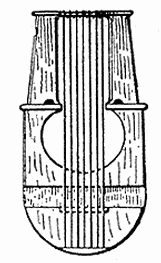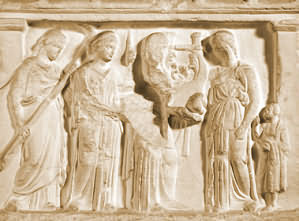
CITHARA
One of the most ancient stringed instruments, traced back to 1700 B.C. among the Semitic races, in Egypt, Assyria, Asia Minor, Greece and the Roman empire, whence the use of it spread over Europe.
 The main
feature of the Greek kithara, its shallow sound-chest, being the
most important part of it, is also that in which developments are
most noticeable; its contour varied considerably during the many
musical ages, but the characteristic in respect of which it
fore-shadowed the precursors of the violin family, and by which
they were distinguished from other contemporary stringed
instruments of the middle ages, was preserved throughout in all
European descendants bearing derived names.
The main
feature of the Greek kithara, its shallow sound-chest, being the
most important part of it, is also that in which developments are
most noticeable; its contour varied considerably during the many
musical ages, but the characteristic in respect of which it
fore-shadowed the precursors of the violin family, and by which
they were distinguished from other contemporary stringed
instruments of the middle ages, was preserved throughout in all
European descendants bearing derived names.
This characteristc flat or delicately arched, connected by ribs or sides of equal width. The cithara may be regarded as an attempt by a more skilful craftsman or race to improve upon the lyre, while retaining some of its features.
The construction of the cithara can fortunately be accurately studied from two actual specimens found in Egypt and preserved in the museums of Berlin and Leiden.
The Leiden cithara, which forms part of the d'Anastasy Collection in the Museum of Antiquities, is in a very good state of preservation. The sound-chest, in the form of an irregular square (17 cm. X 17 cm.), is hollowed out of a solid block of wood from the base, which is open; the little bar, seen through the open base and measuring 21 cm. (1 in.), is also of the same piece of wood.
The arms, one short and one long, are solid and are fixed to the body by means of wooden pins; they are glued as well for greater strength. W. Pleyte states that there are no indications on the instrument of any kind of bridge or attachment for strings except the little half-hoop of iron wire which passes through the base from back to front. To this the strings were probably attached, and the little bar performed the double duty of sound-post and support for strengthening the tail-piece and enabling it to resist the tension of the strings.

Apollo and Artemis with cithara
The oblique transverse bar, rendered necessary by the increasing length of the strings, was characteristic of the Egyptian cithara, whereas the Asiatic and Greek instruments were generally constructed with horizontal bars resting on arms of equal length, the pitch of the strings being varied by thickness and tension, instead of by length.
The number of strings with which the cithara was strung varied from 4 to 19 or 20 at different times; they were added less for the purpose of increasing the compass in the modern sense than to enable the performer to play in the different modes of the Greek musical system.
Terpander is credited with having increased the number of strings to seven; Euclid, quoting him as his authority, states that " loving no more the tetrachordal chant, we will sing aloud new hymns to a seven-toned phorminx."
The strings were vibrated by means of the fingers or plectrum. Twanging with the fingers for strings of gut, hemp or silk was undoubtedly the more artistic method, since the player was able to command various shades of expression which are impossible. Loudness of accent and great brilliancy of tone, however, can only be obtained by the use of the plectrum.
Quotations from the classics abound to show what was the practice of the Greeks and Romans in this respect.
The plectrum was held in the right hand, with elbow outstretched and palm bent inwards, and the strings were plucked with the straightened fingers of the left hand. Both methods were used with intention according to the dictates of art for the sake of the variation in tone colour obtainable thereby.
The strings of the cithara were either knotted round the transverse tuning bar itself (zugon) or to rings threaded over the bar, which enabled the performer to increase or decrease the tension by shifting the knots or rings; or else they were wound round pegs, knobs or pins fixed to the zugon. The other end of the strings was secured to a tail-piece after passing over a flat bridge, or the two were combined in the curious high box tail-piece which acted as a bridge.
Plutarch states that this contrivance was added to the cithara in the days of Cepion, pupil of Terpander. These boxes were hinged in order to allow the lid to be opened for the purpose of securing the strings to some contrivance concealed therein. It is a curious fact that no sculptured cithara provided with this box tail-piece is represented with strings, and in many cases there could never have been any, for the hand and arms are visible across the space that would be filled by the strings, which are always carved in a solid block.
Like the lyre the cithara was made in many sizes, conditioned by the pitch and the use to which the instrument was to be put. These instruments may have been distinguished by different names; the pectis, for instance, is declared by Sappho (22nd fragment) to have been small and shrill; the phorminx, on the other hand, seems to have been identical with the the Greek kithara.
The scope of the solemn games and processions, called Panathenaea, held every four years in honour of the goddess Athena, which originally consisted principally of athletic sports and horse and chariot races, was extended under Peisistratus (c. 540 B.c.), and the celebration made to include contests of singers and instrumentalists, recitations of portions of the Iliad and Odyssey, such as are represented on the frieze of the Parthenon (in the Elgin Room at the British Museum) and later on friezes by Pheidias.
It was at the same period that the first contests for solo-playing on the cithara and for solo aulos-playing were instituted at the 8th Pythian Games.
One of the principal items at these contests for aulos and
cithara was the Nomos Pythikos, descriptive of the victory of
Apollo over the python and of the defeat of the monster."
